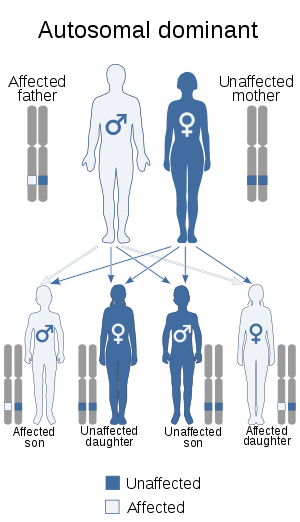Nager acrofacial dysostosis
| Nager acrofacial dysostosis | |
|---|---|
| Synonyms | Mandibulofacial dysostosis with preaxial limb anomalies |
 | |
| Nager acrofacial dysostosis is inherited in an autosomal dominant manner[1] | |
Nager acrofacial dysostosis is a genetic congenital anomaly syndrome. Nager syndrome displays several or all of the following characteristics: underdevelopment of the cheek and jaw area, down-sloping of the opening of the eyes, lack or absence of the lower eyelashes, kidney or stomach reflux, hammer toes, shortened soft palate, lack of development of the internal and external ear, possible cleft palate, underdevelopment or absence of the thumb, hearing loss (see hearing loss with craniofacial syndromes) and shortened forearms, as well as poor movement in the elbow, and may be characterized by accessory tragi.[2] Occasionally, affected individuals develop vertebral anomalies such as scoliosis. The inheritance pattern is said to be autosomal but there are arguments as to whether it is autosomal dominant or autosomal recessive. Most cases tend to be sporadic. Nager syndrome is also linked to five other similar syndromes: Miller syndrome, Treacher Collins, Pierre Robin, Genee-Wiedemann, and Franceschetti-Zwahlen-Klein.
Genetics
Nager syndrome is thought to be caused by haploinsufficiency of the spliceosomal factor SF3B4.[3]
See also
References
- ↑ "OMIM Entry - # 154400 - ACROFACIAL DYSOSTOSIS 1, NAGER TYPE; AFD1". omim.org. Retrieved 19 August 2017.
- ↑ Rapini, Ronald P.; Bolognia, Jean L.; Jorizzo, Joseph L. (2007). Dermatology: 2-Volume Set. St. Louis: Mosby. ISBN 1-4160-2999-0.
- ↑ Bernier FP, Caluseriu O, Ng S, Schwartzentruber J, Buckingham KJ, Innes AM, Jabs EW, Innis JW, Schuette JL, Gorski JL, Byers PH, Andelfinger G, Siu V, Lauzon J, Fernandez BA, McMillin M, Scott RH, Racher H, Majewski J, Nickerson DA, Shendure J, Bamshad MJ, Parboosingh JS (Apr 26, 2012). "Haploinsufficiency of SF3B4, a Component of the Pre-mRNA Spliceosomal Complex, Causes Nager Syndrome". American Journal of Human Genetics. 90 (5): 925–33. doi:10.1016/j.ajhg.2012.04.004. PMID 22541558.
External links
| Classification | |
|---|---|
| External resources |